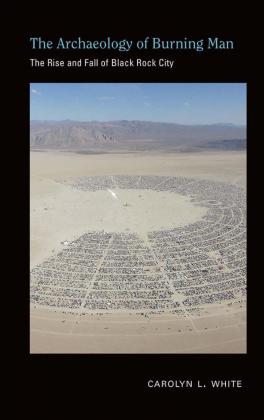Title: "The Archaeology of Burning Man; The Rise and Fall of Black Rock City"
Author: Carolyn L. White
Hardcover: 280 pages, 75 figures, six tables, 6- inch by 9-inch
Published: April 2020
Publisher: University of New Mexico Press, unmpress.com
ISBN: 978-0-8263-6133-2
Black Rock City in the desert of northwestern Nevada is a temporary creation. Each year staff and volunteers descend on the hostile setting in September and their dedicated activities result in the state's sixth-largest population center. It is the epitome of transient human occupation of the natural environment.
Author Carolyn L. White has participated in the Burning Man phenomenon at Black Rock City since 2006. Burning of the massive wooden man, who is about 40 feet in height, is central to the celebration. The burning is symbolic of the renewal of life.
A beach in San Francisco, California was the festival 's first venue. Artist Larry Harvey ereated the 1986 celebration, which had 20 participants. The festival eventually grew into a pilgrimage into the Nevada desert where thousands of creative individuals gather each year.
The author has utilized archaeological methodology to scrutinize various aspects of life and community in this temporary American city. The "happening" welcomes 70,000 people for one week prior to Labor Day; and the structures are dismantled before the end of the month. All evidence of human habitation is "scrubbed" by early October.
"Burning Man's short lifespan and its cyclical nature set it apart from other places---it exists only for one week a year, every year. This place, then, provides an accelerated example of the kinds of structures and social situations that humans create for themselves," writes the author in chapter one.
The following seven chapters examine the world as a shared space, the annual rise of the city, infrastructure of the effigy, households at Black Rock City, themed camps within the city, village life at Black Rock, the "fall of the city" and the epilogue. The book includes an extensive eight-page list of references plus a 16-page index.
Black Rock Desert is known as playa. The term describes a dynamic, harsh ecological system characterized by exposure to lengthy periods of aridity, strong winds, and occasional inundation by salty, turbid, alkaline water during cycles of high precipitation.
The playa in northwestern Nevada, Black Rock Desert National Recreation Area, is one of the largest, flattest, surfaces on Earth, covering approximately 200 square miles. The federal Bureau of Land Management, Department of Interior, is responsible for regulating activities on the public property, which is approximately 90 miles northeast of Reno.
The gathering on the Black Rock Desert NCA has attracted a growing number of participants for more than three decades. It represents a collective respect for the natural environment and a dedication to "Leave No Trace" on public lands.
"Attention to cleanup forms a critical part of the ethos at Burning Man," the author explains in chapter eight.
"Burners take pride in keeping their camps clean and leaving no trace. One of the most common playa-specific terms is MOOP (Matter Out Of Place), which identifies all stray material left on the playa. People who do not take care of their refuse are referred to as MOOPers, a big insult."
Author Carolyn L. White is a professor in the Anthropology Department of the University of Nevada, Reno. She serves as the Anthropology Research Museum director and as the Mamie Kleberg Chair of Historic Preservation at University of NevadaReno. White is editor of The Materiality of Individuality: Archaeological Studies of Individual Lives.
Visit unmpress.com or email ahumme@unm.edu for more information.

